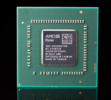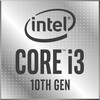AMD Athlon Gold 7220U vs Intel Core i3-1005G1
AMD Athlon Gold 7220U
► remove from comparison
The AMD Athlon Gold 7220U is a mobile processor for cheap laptops of the Mendocino series. It integrates two older Zen 2 cores (similar to the Ryzen 4000 series). The CPU cores clock from 2.4 GHz (base) to 3.7 GHz (single core Turbo) and can use 4 MB L3 cache. Thanks to SMT/Hyperthreading, the CPU can work on 4 threads simultaneously. The integrated memory controller only supports fast LPDDR5 memory (5500 MHz max.). Compared to the faster Mendocino models like the Ryzen 5 7520U, the 7220U offers only two cores and reduced clock speeds, leading to a clearly lower CPU performance.
The integrated graphics card (Radeon 610M iGPU) uses the modern RDNA 2 architecture, but only 2 CUs (128 shaders) and clocks with up to 1.9 GHz.
The CPU performance should be better than the fastest Ryzen dual-core (Ryzen 3 3250U, 2.6 - 3.5 GHz, Zen 1) but clearly stay behind modern quad-core CPUs (in multi threaded tests).
The Mendocino series are produced in a relatively modern 6nm FinFET process at TSMC and should offer a good power efficiency. The Athlon Gold 7220U is rated at 8-15 W TDP and therefore well suited for thin and light laptops.
Intel Core i3-1005G1
► remove from comparison
The Intel Core i3-1005G1 is a low-power, Ice Lake family processor (SoC) featuring 2 cores, 4 threads, 4 MB of L3 cache and the UHD G1 (32 EUs) iGPU. It saw the light of day in 2019. The chip is designed for use in highly portable laptops of the more affordable flavour; the CPU cores run at 1.2 GHz to 3.4 GHz which is not a lot.
Architecture & Features
Ice Lake family chips are powered by Sunny Cove CPU cores.The latter aim to do what Palm Cove cores (that we never really got a chance to get a taste of) were expected to do, delivering a double-digit IPC uplift over the venerable Skylake architecture thanks to a range of small improvements across the board including scheduler improvements, larger caches and buffers, and support for new instruction sets.
Thunderbolt 3 support is built right into the Core i3 (meaning it has several PCIe 3 lanes exclusive to Thunderbolt devices, reducing the number of additional components required for Thunderbolt to work) and so is Intel CNVi Wi-Fi 6 support (making it easier for Intel to sell its proprietary WLAN cards to laptop makers). The Core i3-1005G1 also has the DL Boost and GNA features for applications centered around machine learning.
The 4 GT/s bus is indicative of a consumer-grade chip, since CPUs for gaming laptops and portable workstations usually employ the faster 8 GT/s bus. RAM support is nothing to sneeze at, at up to DDR4-3200 or LPDDR4-3733. NVMe SSDs are supported, with data transfer rates limited to 3.9 GB/s (this is what four PCIe 3 lanes are good for). SATA drives and even eMMC chips are also natively supported here.
This is not a user-replaceable CPU, as it gets permanently soldered to the motherboard (BGA1526 socket interface).
OS support is limited to 64-bit Windows 10 and 64-bit Windows 11, as well as many Linux distros.
Performance
The average 1005G1 in our database is a disappointment, its multi-thread benchmark scores only matching those of Intel's Core i5-7267U and AMD's Ryzen 3 2300U. This is unfortunately in line with what we've been seeing from other Ice Lake family processors; they tend to be held back by their comparatively low clock speeds. While not as slow as many Celerons and Pentiums, this Core i3 will still look out of place in anything but the most affordable laptops and mini-PCs.
With its long-term CPU power limit of 25 W, the Lenovo V17-IIL 82GX008TGE is among the fastest laptops built around this Core i3 that we know of.
Graphics
The Core i3-1005G1 features the UHD Graphics G1 (32 EUs) graphics adapter running at up to 900 MHz. This DX12-compatible iGPU is not much faster than the dated UHD 620 graphics solution, making it almost useless to gamers, and there are no cutting-edge features such as ray tracing support to be found here, either. The list of supported resolutions tops out at 5120 x 3200, and there is no hardware AV1 codec support meaning such a video will be SW-decoded with rather low energy efficiency. The usual HEVC, AVC and VP9 options are supported, thankfully.
The G1 will drive up to 3 monitors simultaneously, provided the system has the outputs required. Higher-end Ice Lake chips are equipped with the G4 (48 EUs) or the G7 (64 EUs) adapters that are significantly faster.
Power consumption
The Core i3 has a 15 W default TDP (also known as the long-term power limit), a value that laptop makers are allowed to reduce slightly - 13 W being the lower limit - resulting in lower clock speeds and lower performance. Either way, that's a tad too high to allow for passively cooled designs.
The SoC is built with Intel's second-gen 10 nm process (not "10 nm SuperFin" or "Intel 7") for average, as of late 2022, energy efficiency.
| Model | AMD Athlon Gold 7220U | Intel Core i3-1005G1 | ||||||||||||||||||||||||||||||||||||||||||||||||
| Codename | Mendocino (Zen 2) | Ice Lake-U | ||||||||||||||||||||||||||||||||||||||||||||||||
| Series | AMD Mendocino (Zen 2, Ryzen 7020) | Intel Ice Lake | ||||||||||||||||||||||||||||||||||||||||||||||||
| Series: Ice Lake Ice Lake-U |
|
| ||||||||||||||||||||||||||||||||||||||||||||||||
| Clock | 2400 - 3700 MHz | 1200 - 3400 MHz | ||||||||||||||||||||||||||||||||||||||||||||||||
| L1 Cache | 128 KB | 96 KB | ||||||||||||||||||||||||||||||||||||||||||||||||
| L2 Cache | 1 MB | 1 MB | ||||||||||||||||||||||||||||||||||||||||||||||||
| L3 Cache | 4 MB | 4 MB | ||||||||||||||||||||||||||||||||||||||||||||||||
| Cores / Threads | 2 / 4 | 2 / 4 | ||||||||||||||||||||||||||||||||||||||||||||||||
| TDP | 15 Watt | 15 Watt | ||||||||||||||||||||||||||||||||||||||||||||||||
| Technology | 6 nm | 10 nm | ||||||||||||||||||||||||||||||||||||||||||||||||
| Features | XFR, FMA3, SSE 4.2, AVX2, SMT | DDR4-3200/LPDDR4-3733 RAM, PCIe 3, 4 GT/s bus, DL Boost, GNA, MMX, SSE, SSE2, SSE3, SSSE3, SSE4.1, SSE4.2, AVX, AVX2, AVX-512, BMI2, ABM, FMA, ADX, VMX, SMEP, SMAP, EIST, TM1, TM2, Hyper-Threading, Turbo, SST, AES-NI, RDRAND, RDSEED, SHA, SGX | ||||||||||||||||||||||||||||||||||||||||||||||||
| iGPU | AMD Radeon 610M ( - 1900 MHz) | Intel UHD Graphics G1 (Ice Lake 32 EU) (300 - 900 MHz) | ||||||||||||||||||||||||||||||||||||||||||||||||
| Architecture | x86 | x86 | ||||||||||||||||||||||||||||||||||||||||||||||||
| Announced | ||||||||||||||||||||||||||||||||||||||||||||||||||
| Manufacturer | www.amd.com | ark.intel.com | ||||||||||||||||||||||||||||||||||||||||||||||||
| max. Temp. | 100 °C | |||||||||||||||||||||||||||||||||||||||||||||||||
| Socket | BGA1526 |
Benchmarks
Average Benchmarks AMD Athlon Gold 7220U → 100% n=2
Average Benchmarks Intel Core i3-1005G1 → 118% n=2
* Smaller numbers mean a higher performance
1 This benchmark is not used for the average calculation













